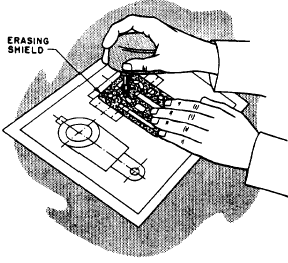|
ERASERS AND ERASING
ACCESSORIES You must be very careful in selecting an eraser
that will remove pencil or ink lines without damaging
the surface of the drawing sheet.
A vinyl eraser (fig. 2-2, view A) is ideal for
erasing lines drawn on tracing cloth and films. An
ordinary double-beveled pencil eraser generally
comes in red or in pink color (sometimes called a
PINK PEARL). A harder eraser (sometimes called a
RUBY RED) (fig. 2-2, view B) is designed for erasing
lines in ink. The ART GUM eraser (fig. 2-2, view C),
made of soft pliable gum, will not mar or scratch. It is
ideally suited for removing pencil or finger marks and
smudges.
You can also use a kneaded eraserthe type
used by artists. It is a rubber dough, kneadable in
your hand, and has the advantage of leaving very
little refuse on the drawing sheet.
The so-called STEEL ERASER, shown in figure
2-3, is, of course, actually a scraper. It is used
principally for scraping off erroneous ink lines,
especially from tracing cloth. The figure shows a
short-bladed steel eraser; long-bladed steel erasers
are also available. A steel eraser is not generally
recommended for use by beginners because it has a
tendency to damage the surface of the drawing sheet.
Figure 2-4 shows an ELECTRIC ERASER. The
control switch is directly under the fingertip;

Figure 2-3.-Steel eraser.

Figure 2-4.-Electric eraser.
the body of the machine fits comfortably in the
palm of the hand, and the rotating eraser can be
directed as accurately as a pencil point. Refills for
either ink or pencil erasing are available.
CAUTION: Do not hold the electric eraser
steady in one spot, or you may easily wear a hole
or damage the surface of the material being
erased.
When there are many lines close together and
only one needs to be removed or changed, the
desired lines may be protected by an erasing
shield, as shown in figure 2-5.
Finely pulverized gum eraser particles are
available in squeeze bottles or in DRY CLEAN
PADS for keeping a drawing clean while you
work on it. If a drawing or tracing is sprinkled
occasionally with gum eraser particles, triangles,
T squares, scales, french curves, and the like, not
only tend to stay clean themselves, but also tend
to clean the drawing or tracing as they are
moved over the surface.
Before a drawing is inked, it is usually
prepared by sprinkling on POUNCE (a very
fine bone dust) and then rubbing in the pounce
with a felt pad on the container. Pounce helps
to prevent a freshly inked line from spreading.
A draftsmans DUST BRUSH should be used
for brushing dust and erasure particles off a
drawing.

Figure 2-5.-Use of an erasing
shield.
|

